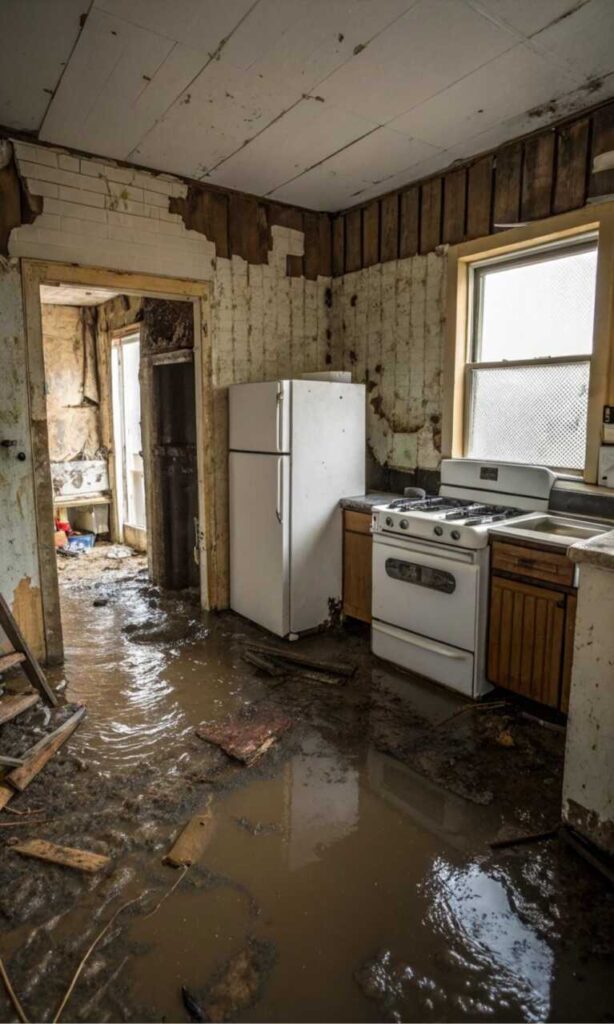
Contents
When faced with a flooded home, every moment counts. Swift action is essential for Flooded Home Recovery, from immediate water extraction to thorough drying. Knowing the right steps can make all the difference in minimizing damage and preventing mold growth. By implementing effective restoration strategies, you can protect your home and prepare for future incidents. Let’s explore the best solutions to restore your space and peace of mind.
Key Takeaways
- Conduct a thorough assessment of damage, documenting structural issues and moisture levels for insurance claims.
- Remove standing water using wet/dry vacuums or submersible pumps as needed.
- Use fans and dehumidifiers to promote airflow and reduce humidity for effective drying.
- Repair leaks and improve ventilation to prevent future mold growth and water intrusion.
- Prepare for future floods by creating an emergency kit and maintaining proper drainage around your home.
Assessing the Damage: Initial Steps After Flooding
After a flood, the first step you should take is to assess the damage to your home. Start with an initial inspection, focusing on the areas most affected by water. Look for signs of structural damage, such as cracks in the walls or ceilings, and check for standing water or moisture levels.
Document everything you find; this damage assessment will be vital for insurance claims and repairs.
As you evaluate your home, remember to prioritize safety. If you notice any electrical issues or unstable structures, it’s best to contact professionals.
Don’t rush the process; take your time to ensure you’ve captured all the details.
This step can feel overwhelming, but you’re not alone. Many have faced similar challenges, and reaching out for support can make a difference.
Once you’ve completed your assessment, you’ll be one step closer to restoring your home and peace of mind.
Emergency Water Extraction Techniques
Once you’ve assessed the damage, it’s time to tackle the water sitting in your home. Effective water removal methods are essential for preventing further damage. You can start with the right extraction equipment, which can make a significant difference in your recovery efforts.
Here’s a quick overview of some techniques:
| Technique | Description |
|---|---|
| Wet/Dry Vacuum | Ideal for small amounts of standing water. |
| Submersible Pumps | Best for larger volumes of water. |
| Squeegees | Useful for moving water toward drains. |
| Towels and Mops | Good for absorbing residual moisture. |
| Dehumidifiers | Helps remove moisture from the air. |
Drying and Dehumidification Processes
As you begin the drying process, understanding how to effectively dehumidify your home is crucial for preventing mold growth and further damage.
Start by evaluating your space and selecting the right dehumidifier; consider the size of the area and the moisture level. A high-capacity unit can speed up the drying time considerably.
In addition to dehumidifier selection, employ various drying techniques to enhance efficiency. Open windows and doors when possible to encourage airflow, and use fans to circulate the air.
Remember, the faster you dry out the affected areas, the less likely mold will take hold.
Monitor humidity levels regularly to verify they’re dropping.
It’s a team effort to reclaim your home after flooding, so don’t hesitate to reach out to professionals if needed.
You’re not alone in this journey, and with the right approach, you can restore your space to its former glory.
Mold Prevention Strategies
Even with effective drying and dehumidification, mold can still pose a threat if not properly managed.
Understanding the various mold types and implementing solid prevention methods is essential for your home’s health.
Here are some strategies you can use:
- Keep humidity levels below 60%: Use dehumidifiers and air conditioners to control moisture.
- Fix leaks promptly: Address any plumbing or roofing issues to prevent water intrusion.
- Ventilate properly: Make sure bathrooms, kitchens, and laundry rooms have adequate ventilation to reduce moisture buildup.
- Regularly inspect for mold: Check hidden areas like behind appliances and in basements to catch any issues early.
Repairing and Restoring Your Home
After experiencing a flood, evaluating water damage is essential to understand what needs repair.
You’ll want to address any issues quickly to prevent mold growth and further complications.
Let’s explore how to effectively restore your home and keep it safe from future damage.
Assessing Water Damage
When you return to your home after a flood, evaluating the water damage is essential for effective recovery.
Start by identifying the water source, as this will help prevent future issues. Next, conduct a structural integrity evaluation to ensure your home remains safe.
Here are a few key steps to follow:
- Inspect walls, floors, and ceilings for warping or discoloration.
- Check electrical systems and appliances for damage.
- Remove any damaged materials like carpets or drywall.
- Document everything for insurance claims.
Mold Prevention Strategies
Once you’ve assessed the water damage, tackling mold prevention becomes a top priority.
Mold types can vary, but taking proactive steps can help protect your home. Start with moisture control; keep humidity below 60% using dehumidifiers.
Enhance air circulation by opening windows and using fans to promote drying. Employ effective cleaning techniques, like using bleach solutions on hard surfaces, to eliminate spores.
Don’t forget surface treatments; applying mold-resistant paints can safeguard areas prone to dampness.
Regularly inspect hidden spaces, such as basements and attics, to catch potential problems early.
Tips for Future Flood Preparedness
To be ready for future floods, you need to take proactive steps now.
Start by assembling an emergency kit with essentials, elevate your electrical systems, and consider landscaping strategies that promote drainage.
These measures can greatly reduce damage and help keep your home safe.
Emergency Kit Essentials
Having an emergency kit ready can make all the difference during a flood.
It’s vital to gather supplies that can keep you and your loved ones safe. Here’s what you should include in your kit:
- First aid supplies: Bandages, antiseptic wipes, and pain relievers can help with injuries.
- Non-perishable food: Stock up on energy bars, canned goods, and dried fruits.
- Water: Aim for at least one gallon per person per day for three days.
- Flashlights and batteries: Power outages are common, so having light sources is important.
Elevate Electrical Systems
Elevating your electrical systems is essential for protecting your home from future flood damage. Start by considering electrical upgrades that raise your wiring above potential flood levels. This isn’t just about safety; it’s about peace of mind for you and your loved ones.
Adhering to current wiring standards is vital, ensuring your systems can withstand possible water exposure. Consider installing waterproof outlets and circuit breakers in elevated areas to further safeguard your home.
You might also want to consult a licensed electrician who understands local regulations and can recommend effective solutions tailored to your needs. By taking these proactive steps, you’ll create a safer environment for your family and foster a greater sense of belonging in your community, knowing you’re prepared for whatever comes next.
Landscape for Drainage
When protecting your home from future floods, landscaping for proper drainage is key. Implementing effective drainage systems and proper landscape grading can greatly reduce your flood risk.
Here are some essential tips to take into account:
- Create swales to redirect water away from your foundation.
- Install French drains to collect and channel excess water.
- Use native plants that absorb more water and improve soil stability.
- Regularly maintain gutters to ensure they’re clear of debris.
Recap
Recovering from a flood can feel overwhelming, but taking swift action makes a difference. By following these steps—assessing damage, extracting water, and preventing mold—you can restore your home and reduce future risks. Stay proactive with maintenance and be prepared for potential flooding. Your home deserves it, and so do you. Remember, a little preparation today can save you a lot of trouble tomorrow.
Recent Posts
What Are the Top Mold Prevention Tips After Flooding?
You might think mold prevention isn’t a priority after flooding, but it’s essential for your
Essential Mold Prevention Tips Post-Flooding
Imagine standing in a damp, musty room, where the remnants of floodwater linger and the
Ultimate Flood Cleanup and Restoration Strategies
When faced with the aftermath of a flood, it’s essential to approach the flood cleanup
